Ensuring the right feed at the right time for chicks
Receive all our future audio articles in your mailbox
Sounding similar, feed and feeding are two different things. Both are crucial for the success of your poultry operation. Feed is about the nutritional and physical properties of the feed itself, while feeding is about how to properly provide feed to the chickens. Why is it important to understand both and how do you know what is right for your flock?
Composition of feed
Feed companies usually provide a feed program that supplies the basic nutrients required for your birds. The main ingredients of these programs tend to be corn and wheat for starch (energy), while soy is the main source of protein (amino acids). Depending on nutrient requirements, other raw materials are added for extra energy density (oils, fats), fiber (brans, hulls), or mineralization (monocalcium phosphate, limestone, salt).
Besides these major components, a variety of feed additives or functional feed ingredients are often added to nurture the birds based on their requirements or even to improve their utilization of the feed. These functional feed ingredients include vitamins, trace elements, enzymes, medium-chain fatty acids, phytogenic components, etc.
Construction of feed
Another variable to feed is the structure. In general, there are 3 different structures commonly fed to poultry: mashed, pressed pellet, and crumbled.
- Mashed feed is a milled and mixed composition with certain requirements in terms of particle size and homogeneity. It is commonly used in layer feeds.
- Pressed pellet feed is mashed feed compressed and conditioned into a pellet. Common in broilers and turkey meat production, this form prevents sorting and triggers higher feed intake.
- Crumbled or granulated is the third common structure. This composite is achieved when a pellet is crumbled into smaller particles. This type is typically used in early feeding, as it encourages early feed intake. It is also a good size for smaller or recently de-beaked birds.
types of feed structure

Adapted feeding program
The selection of the feedstuff depends on the region, breed, and age of the birds. If there is also an added value program—non-GMO, organic, slow-growing, antibiotic/anti-coccidial free—there will be additional adaptions to the diet. Subject to all these inputs, the feed can be fortified with functional feed ingredients to support specific concerns like wet litter, high or low daily gain, or bone issues to name a few.
From all these factors, the feeding scheme (changing the nu-trient composition throughout the bird’s life) can range from a 3 to 5-part feeding plan. No matter the structure, it is always advised to provide a prestarter to jumpstart the flock’s gut development and health.
Changing the diet throughout the bird’s life is important to meet its needs where it is at. An example is a finisher feed with high energy density and relatively low protein levels, this feed is not appropriate to supply the sufficient amino acid demands very young birds require. Furthermore, the wrong feed at the wrong time may harm the feed intake develop-ment, causing disturbances in the gastrointestinal tract, and lead to performance issues.
Speak to a nutrition expert in your region for specific information but remember two major points: - Know your setup, so you know what feeding plan is required - Be sure to feed the right feed at the right time.
Feeding the feed
This brings us to feeding management, or how to give the feed to the birds. Let’s start with the arrival of the day-old chicks. The starter feed should be present in the feeders between 12 and 2 hours before the arrival of the chicks. Any longer and the warm conditions in the barn could harm the feed quality. Any shorter and the feed temperature might not be adapted to the environment.
Shown to be beneficial for the early start of every chick, additional feeders or biodegradable chick paper is encouraged. It is advised to provide a dedicated pre-starter on the chick paper (20-40g/bird) and the regular starter feed in the feeding lines. Be sure there is sufficient water and the feeding lines are down so the birds can reach the feed.
In short, feed and feeding are not the same. Depending on the farm, the nutrition needs of the feed will change, as will the structure and method of delivery. Still, some principles are universal and include ensuring the minimum daily intake requirements are filled, as is giving day-old chicks the best start with a prestarter. When it comes to a healthy and productive flock, every day counts, especially for fast-growing birds like broilers. In fact, one day accounts for approximately 2.5% of a 40-day cycle. This is why it is essential to provide the right feed at the right time to your flock.
This contact was suggested based on the location you are browsing from. You can of course also consult our other contacts and locations here.

